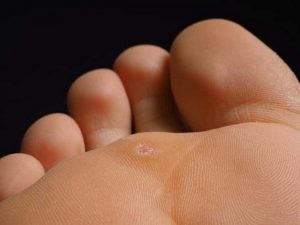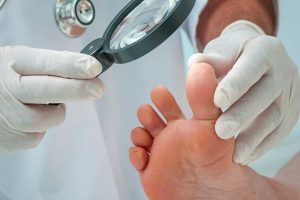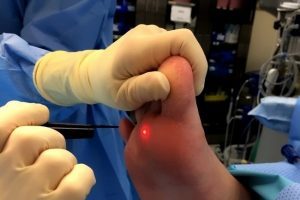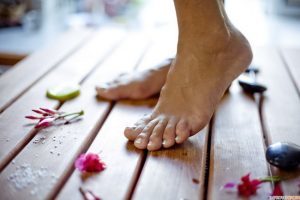Plantar warts are a growth in the skin of a viral nature, it is also called corn. From medical terms it is clear that such formations are localized on the soles of the feet and feet. From a cancer risk standpoint, they are not dangerous, but they do cause a great deal of discomfort when walking due to painful compression.
Causes of plantar warts
All types of warts, e. g. mt plantar warts, are caused by human papillomavirus (HPV). You can get it through close contact with infected people or through daily life. The virus dies quickly from sunlight, but it feels good in high humidity. As a result, HPV infection often occurs in baths, saunas, swimming pools. Facilitating the penetration of the virus into the body through microtrauma and cracks in the skin, as well as reduced immunity.

With strong protective properties of the body, the virus can be dormant for an indefinite period of time after infection. But if immunity is reduced, it begins to multiply actively, evoking the appearance of warts from various locations on the skin. In their case, only 1, 2, 4, 27 and 57 subtypes of HPV are usually responsible.
Several predisposing factors contribute to the appearance of such images:
- shoes that are too tight or too large;
- high heels;
- various deformities of the foot (including flat feet);
- various diseases of the joints of the legs (arthritis, arthritis, etc. ).
Warts on the legs are more common in people with too dry skin and overgrowth.
Thus, the causes of plantar warts are the same in all cases (HPV infection), but the tendency factors are different. The number and size of elements on the skin depend on them and the immune state.
How plantar warts appear
Wart on the foot looks like rounded skin growth. It can be in different sizes, but rarely over two centimeters in diameter. It rises above the level of the skin by no more than three millimeters, but at the same time it goes deep inside with its root. The color may not be different from the surrounding skin or darker or lighter. Often such formations have a yellow or gray tinge. Visually, when viewed within the elements, black dots or lines can be seen (they are also clearly visible in the image) This is what capillaries look like, where blood clots have formed, due to the compression of Horny vessels by the masses.
At first, the plantar wart has a smooth surface. But over time, it becomes hard, rough, thickened. It is the horny mass that gives these warts their yellow color.
Important symptoms of plantar warts are pain when compressed. Each step causes severe pain to the patient.
These warts are very similar to plant slides. The resemblance to the cornice is particularly noticeable due to the intense pain in both forms. The main difference is that there is no skin pattern on the surface of the warts, but on the scalp it is still.
Analysis of plant warts
A competent dermatologist diagnoses this disease on the basis of a single clinical picture. In some cases, additional dermatoscopy is needed. Lack of skin pattern formation and the presence of capillaries with a blood clot in its structure confirms this diagnosis.
Treatment of plantar warts

Plantar warts are harder to get rid of than similar formations in other areas due to their deeper penetration into the skin. In the case of small and newly formed elements, dispersive external preparations can be used. Large and deep warts are removed surgically. At the same time, old formations should first be softened with keratolytic drugs.
External preparations for removing warts
In some cases, such self-destruction is possible. But since the plant guard hurts quite severely, patients do not want to wait and try to get rid of them as soon as possible.
Any herbal remedy for lethal effects is prescribed to remove small and superficial elements.
These products contain acids that coagulate skin proteins and cause necrosis. The medicines containing refrigerant have a similar effect. But they have a dispersive effect on tissue freezing, not on chemical damage.
All of these drugs are used correctly during synthesis. Care must be taken to ensure that the material does not fall on nearby tissues, as this will cause them to burn. After treatment, the wound will remain on the site of the former wart, which will be covered with crust. After healing, it will fall on its own. You can perform such treatment at home, but only as directed by your doctor.
In this way, small-sized, shallow penetration of warts can only be removed into the skin. For large items, you need to choose other methods of removal, as imperfect destruction of the wart tissue will definitely lead to its recurrence.
Surgery to remove plantar warts

There are various ways to remove plantar warts surgically. Mild methods are preferred:
- solvent;
- radio wave knife;
- cryodestruction;
- electrification.
All of these operations are performed on an outpatient basis. Patients can go home literally a few minutes after they finish, they just need to treat the wound at home regularly.
The most effective and safest way to remove plantar warts is by cutting with a laser wave or a radio wave knife. When performed, vessels immediately clot, which is a good prevention against bleeding and secondary infection. Complications of removing skin lesions with these methods are extremely rare. The same can not be said for herbal remedies and coagulation, so these therapies have faded into the background and are rarely used.
If the warts are large or old (covered with a large amount of horny mass), it is recommended to treat them with keratolytic drugs for two weeks before removing the procedure. For this purpose, salicylic ointment or acid and other drugs are prescribed. This makes it possible to classify parts of the corners of the scales to make the formations softer and more flexible. This will make it easier and faster to remove the wart.
In rare cases, if there are many factors or doubts about their nature, your doctor may recommend surgery with surgery. With this method of removing warts, the rehabilitation period and high risk of scarring is much longer, so it is only used under strict indications.
Properties of plant warts in children
In children over the age of five, plantar warts are quite common as they often run barefoot, injured and do not always follow the rules of personal hygiene. Failure of immunity due to regular contact with sick children (in kindergartens and schools) leading to increased likelihood of warts.
Treatment of such images in a child is best started with external drugs. You can try clarifying the basic elements using salicylic ointment, followed by weeks. Immunosuppressants have proven successful. When used regularly on the wart, they can be removed in a few weeks.
If the elements are deep, use a killer or remove them with a laser or radio wave machine.
Plant warts prevention

It is completely impossible to protect yourself against warts, but you can reduce the risk of them appearing. To do this, you need to respond in two directions: eliminate the tendency of factors and stimulate the body's defenses.
To achieve your first goal, you need:
- follow the rules of personal hygiene (do not walk barefoot in public, wash your feet daily and treat cuts and injuries in a timely manner);
- choose comfortable shoes by size;
- to prevent foot deformity and treat joint diseases.
A healthy lifestyle, playing sports, tightening, taking vitamin complexes and immunostimulants as prescribed by your doctor will help maintain your body's defenses at a good level.
In case of dry skin and overgrowth, it is recommended to have regular medical foot surgery and peeling. In case of severe sweating of the legs, you need to use special drugs to treat hyperhidrosis. By following all these rules, the risk of developing warts on the soles of the feet is minimal.
Plantar warts are not a dangerous disease but they cause a lot of discomfort due to pain when walking. Fortunately, modern medicine has many ways to get rid of it quickly and with minimal risk of new attacks. To do this you need to consult a dermatologist and follow exactly all his instructions and recommendations.















































































